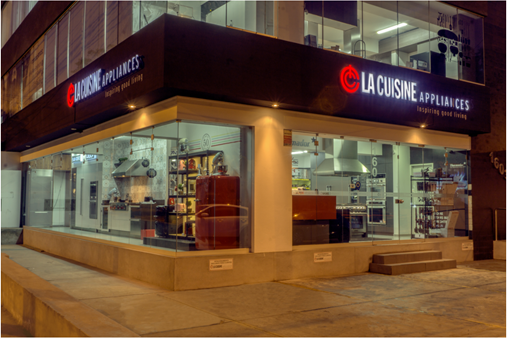
Our Company
Locations
Contact Us
Newsletter
Sign up to receive email updates on the latest products, collections and campaigns.
Gaggenau knows well the weight that the brand’s values have had in its history. For that precise reason, its website dedicates a space to identify those great values, whose growth has been promoted by the brand over the years, in the history of architectural works of art, designers, artists, architects, and events.
The fact is that a brand’s values are one of the most important assets a company can have. Although intangible, and often unnoticeable, their purpose is to strengthen the identity of a firm/company, make it stand out among its competitors and of course, to account for the achievements accumulated throughout its history.
That is why the structure of Gaggenau – The Magazine is based on 4 important pillars: culture, design, spaces, and taste. These pillars are present in the philosophy of the brand and, following, we share 3 great examples of the same.
The history of Gaggenau began in 1683. With 336 years behind it, Gaggenau knows what it means to renovate and reinvent itself, without allowing the years alter its ability to innovate or end with the pioneer spirit. For that precise reason, the article written by Dominique Afacan (Work in progress: meet the creatives who haven’t let age slow them down), gives a perfect account of the brand’s philosophy.
The article deals with 3 interesting stories of people over 70-years-old who did not allow age to set an expiration date on their creativity, illusions, curiosity and desires to innovate within their community. British plastic artist Tess Jaray; the neo-pagan leader and director of the Icelandic Reykjavik store; Jörmundur Ingi Hansen, and the social media writer and influencer Sue Kreitzman were the three personalities who spoke about their age as a gift wrapped in experience.
Gaggenau understands well how daring to innovate can make a difference. The brand that began as a casting plant in Rotenfels and a hammer mill and nail forging plant, is currently a paradigm of design, “Made in Germany” quality, and high technology. As a result of this, Gaggenau has placed its name among the most prestigious companies in the world in terms of the manufacture of domestic appliances.
That is why the history of the restaurant KOKS (Northern star: how one chef put the Faroe Islands on the world’s culinary map) and how its chef Poul Andrias Ziska put the Faroe Islands on the culinary map of the world, is so in tune with Gaggenau’s philosophy. The restaurant located in an archipelago in the icy waters of the North Atlantic has earned its first Michelin star thanks to its interesting interpretation of the traditional cuisine of the Faroe Islands (Denmark).
At KOKS, chef Poul Andrias Ziska combines ancestral techniques and ingredients from Raest (a traditional process for curing meat with the salty ocean breeze) with a modern culinary vision to create elegant flavors that conquer the palate of the demanding diners of the 21st century.
What could Gaggenau have in common with a brand of luxury sports vehicles like Aston Martin? In fact, much more than you could imagine. It happens that both the German brand of luxury appliances and the British brand of high-standing cars, are motivated by the same goal: the desire to go further.
In the article When Aston Martin met Gaggenau: a conversation, Sven Baacke, Head of Design of the Global brand Gaggenau, and Marek Reichman, Vice President and Chief Creative Officer of Aston Martin, find the common ground in terms of the manufacture processes of both companies.
Their conclusion? The functional and aesthetic aspects don’t have to be divorced. The holistic approach of both brands has successfully managed to go beyond the technical constraints of each industry to create machines/appliances that are as beautiful as they are highly functional.
So, the great values of the Gaggenau “savoir faire” can be perceived not only in the high quality of its beautiful and smart appliances, but also in the stories of others that portray the image of the brand as a sort of mirror.

Sign up to receive email updates on the latest products, collections and campaigns.
Carrera 9 Nº80-45
Bogotá D.C., Colombia
Monday to Friday: 11:00 a.m. - 07:00 p.m.
Saturday: 11:00 a.m. - 06:00 p.m.
(+571) 432.7408/7493

Calle 77 #72-37
Barranquilla, Colombia
Monday to Friday: 08:00 a.m. - 06:00 p.m.
Saturday: 09:00 a.m. - 01:00 p.m.
(+57) 605 352 0851

Edificio La Cuisine
Costado Suroeste, C.C. La Paco
Escazú, Costa Rica
Monday to Friday: 09:00 a.m. - 05:00 p.m.
Saturday: 10:00 a.m. - 04:00 p.m.
(+506) 4000.3555

Galerías de Puntacana No. 51
Punta Cana, La Altagracia, R.D.
Monday to Friday: 09:00 a.m. - 06:00 p.m.
Saturday: 10:00 a.m. - 01:00 p.m.
(809) 378.9999

C/Rafael Augusto Sánchez No.22,
Piantini, Santo Domingo, R.D.
Monday to Friday: 09:00 a.m. - 06:00 p.m.
Saturday: 09:00 a.m. - 01:00 p.m.
(809) 378.9999

18187 Biscayne Bvld., Aventura
FL 33160
Monday to Friday: 10:00 a.m. - 06:00 p.m.
Saturdays by appointment.
(786) 322 5432
www.lacuisineappliances.com
sales@lacuisineappliances.com

3232 Coral Way,
Miami FL 33145
Monday to Friday: 10:00 a.m. - 06:00 p.m.
Saturday: 10:00 a.m. - 03:00 p.m
(305) 442-9006
www.lacuisineappliances.com

2005 NW 115th Avenue
Miami, FL 33172
Monday to Friday: 09:00 a.m. - 05:30 p.m.
Saturday: Closed
(+1) 305 418.0010
info@lacuisineinternational.com

Obarrio. Av. Samuel Lewis,
Addison House Plaza,
Local No.11, Panamá
Monday to Friday: 09:00 a.m. - 06:00 p.m.
Saturday: 10:00 a.m. - 04:00 p.m.
(+507) 265.2546/2547

Av. Caminos del Inca 1603,
Santiago de Surco, Perú
Monday to Friday: 10:00 a.m. – 07:00 p.m.
Saturday: 10:00 a.m. – 01:00 p.m.
(+511) 637.7087

Centro Comercial San Ignacio, Nivel C, local No.5
Caracas, Venezuela
Monday to Saturday: 10:00 a.m. – 07:00 p.m.
(+58) 212 264.5252
(+58) 414 018.5352 (Wholesale)
ventas@lacuisineappliances.com

Complejo Pradera Ofibodegas No.13,
20 calle final Z. 10 Km. 6.8 Carretera a Muxbal,
Santa Catarina Pínula, Guatemala
Monday to Friday: 08:00 a.m. - 05:30 p.m.
Saturday: 09:00 a.m. - 12:30 p.m.
(+502) 6671-3400
